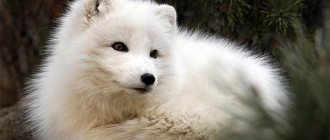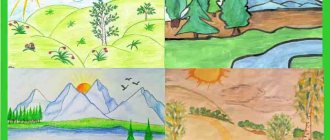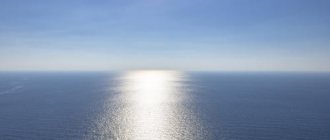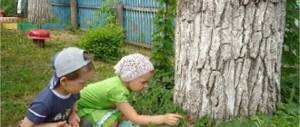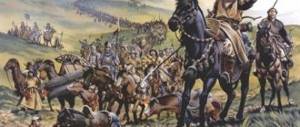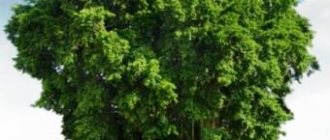Lesson No. 24. “The water resources of our region”
#4th grade #The world around us #Federal State Educational Standards #Methodological developments #Lesson #Primary school teacher #Additional education teacher #School education #MK "School of Russia"
Reservoirs of the Kirov region
The riddle ran away from the mountains without looking back, played hide and seek with a stream, is wide and deep, it is fast...
A river is a constant water stream flowing in a natural channel from source to mouth, with tributaries. A river is a constant water stream flowing in a natural channel from source to mouth, with tributaries.
Rivers of the Kirov region A total of 19,753 rivers in the region 95% (18,688) have a length of up to 10 km 5% (982) have a length from 10 to 50 km 83 rivers have a length of more than 50 km The total length of the rivers of the region is 66,650 km, i.e. 1.5 times the length of the equator.
Rivers of the Kirov region Main river - Vyatka Longest rivers (within the region): Vyatka - 1250 km Kama - 551 km Moloma - 419 km Pizhma - 220 km Luza - 210 km Kobra - 205 km Cheptsa - 200 km
Rivers and relief Most of the rivers in the region are flat. Current speed is from 10 cm/s to 1 m/s. The right bank is steep. The left bank is flat.
Feeding of the rivers of the Kirov region Snow (spring) Rain (summer and autumn) Underground (all year round) Mixed
Riddle I hide in winter. I appear in the spring. I have fun in the summer. In the fall I go to bed. What will we talk about? About the river mode.
River regime Rivers freeze in mid-November The greatest thickness of ice (from 30 to 70 cm): end of March Duration of freeze-up is about 5.5 months 4. Ice drift on large rivers - about a week, on small rivers - 1-2 days 5. Rivers are free of ice 180-200 days
River regime Spring flood Water rise: early April - mid-June Water level rises by 4-6 m - on large rivers; by 2-3 m - on small rivers. In front of us is the flooded Dymkovo
The importance of rivers Water meadows in river floodplains Resting place
Importance of rivers For domestic needs Shipping
The main water artery of the Kirov region is the Vyatka River.
The Vyatka River Flows through the territory of Udmurtia, the Kirov region, Tatarstan Source - Verkhnekamsk Upland Mouth - Kama River Length 1314 km Basin area 129000 km² The largest right tributary of the Kama River.
Tributaries of the Vyatka Right tributaries Kobra Velikaya Medyanka Moloma Tansy Left tributaries Belaya Kholunitsa Cheptsa Bystritsa Kilmez Voya
Cities of the Kirov region on the Vyatka River Kirs Omutninsk Slobodskoy Kirovo-Chepetsk Kirov Orlov Kotelnich Sovetsk Nolinsk Malmyzh Urzhum Vyatskie Polyany The Vyatka River near the city of Kotelnich
River Yug Flows through the territory of the Vologda and Kirov regions Source - Northern Uvaly Mouth - Northern Dvina River Length - 574 km Basin area 35,600 km² Confluence of the South (pictured left) and Sukhona
The Vetluga River flows through the territory of the Kostroma, Kirov, Nizhny Novgorod regions, and the Mari El Republic. Estuary - Cheboksary Reservoir - Volga River basin. Length 889 km.
The Moloma River flows through the northwestern regions of the region and flows into the Vyatka River near the city of Kotelnich. The river valley is wide. In summer it becomes very shallow.
Cheptsa River The largest tributary of the Vyatka originates in Udmurtia. It flows into the Vyatka near the city of Kirovo-Chepetsk. It floods heavily in the spring and is used for shipping.
Vyatka Vyatka Vyatka Moloma Luza Luza Cheptsa Vetluga Cobra Tansy Luza Kama Kilmez 2 1 1 – lake Lezhninskoye 2 – lake Shaitan South
A riddle-charade It starts with “O”, It is found in the mountains, It is not repeated anywhere And it ends with “O”, So this is...
A lake is a natural closed body of water located in natural depressions of the earth’s surface. A lake is a natural closed body of water located in natural depressions of the earth’s surface.
Types of lakes in the Kirov region Floodplain (formed during river floods in the depressions of the land or in old river beds) Glacial (formed during the melting of a glacier) - mainly located in the northern part of the region. Karst (formed by groundwater) - found in the southern regions of the region.
Floodplain lake Floodplain lake Karst lake
Lakes of the Kirov region The largest lakes Akshuben (Tuzhinsky district) - 85 hectares Orlovskoye (Kumensky district) - 63 hectares Muserskoye (Sanchursky district) - 32 hectares The deepest - Lake Lezhninskoye (Pizhansky district) - 36.6 m The most mysterious - Lake Shaitan ( Urzhumsky district).
Lake Lezhninskoe Lake of karst origin. The water in it is unusually clear and very cold. The lake is inhabited by crayfish, which indicates the purity of the water. There is practically no vegetation in the lake.
Lake Shaitan Translated from Mari it means “goblin”. The length and width of the lake is about 200m, the depth reaches 12m. The attraction of the lake are the floating islands. In some years, water surges up to 20m high are observed on the island.
Test yourself 1. Most of the rivers in the Kirov region are: a) up to 10 km long; b) from 10 to 50 km; c) over 50 km. 2. All year round, rivers receive food from a) rain; b) underground; c) snowy. 3. The rise of water in rivers in spring is called... a) ice drift; b) flood.
Test yourself 4. The largest tributary of the Vyatka a) Bystritsa b) Moloma c) Cheptsa 5. The right tributary of the Vyatka, the name of which coincides with the name of the reptile: a) Viper b) Cobra c) Already
Test yourself 6. The deepest lake in the Kirov region a) Shaitan b) Akshuben c) Lezhninskoye 7. A unique natural reservoir in the Urzhum region with water emissions a) Muserskoye b) Shaitan c) Lezhninskoye
Correct answers 1a 2b 3b 4c 5b 6c 7b
Determine the names of reservoirs 3 1 2 5 4
Correct answers 1 – Cheptsa River 2 – Moloma River 3 – Vyatka River 4 – Lake Shaitan 5 – Lake Lezhninskoye
Lesson on the surrounding world in 4th grade on the topic “RESERVOIRS OF OUR EDGE”
Students make their suggestions. The teacher summarizes the students' statements.
Teacher.
The water that falls from the clouds onto the surface of the earth partially seeps into the ground, forming groundwater. Some of it flows over the surface of the earth, some evaporates. Underground water in exposed areas comes out, forming springs. From springs in the form of streams, water flows along a slope. Streams, connecting with each other, form the source of the river (Fig. 2).
Other rivers flow into the river. These are its tributaries. They are usually shorter than the main river. The more tributaries, the more water the river has. The place where a river flows into another river, sea, or lake is called an estuary. The length of rivers varies - from tens of kilometers to several thousand.
The speed of a river's flow depends on the area through which it flows. On the plains the river flow is smooth, in the mountains it is stormy.
Water constantly flows into the river. In summer, our rivers are fed by rain and groundwater. A lot of water enters the river in the spring from melting snow. At this time, rivers often overflow their banks, flood vast low areas, and floods begin.
In winter, rivers are fed by the release of groundwater.
Lakes, unlike rivers, have neither a source nor a mouth (Fig. 3). These are natural depressions on the land surface filled with water. Some lakes have fresh water, while others have salt water.
The lakes are also fed by groundwater and surface water. Rivers often flow into them. For example, many rivers flow into Lake Ladoga, but only the Neva, on which St. Petersburg stands, flows out.
In winter, our reservoirs are covered with ice. Ice first forms along the banks and then covers the entire surface of the river or lake. However, on many rivers there remain areas not covered with ice for a long time (full waters - polynyas). Be aware that these areas are very dangerous to cross. Don't go out on the ice. Don't rush to skate on thin ice.
In spring, the ice begins to melt, first along the shores, and then in the middle. Spring ice is very deceptive; it is porous and therefore fragile. Crossing bodies of water on spring ice is extremely dangerous.
You need to be especially careful on the water in the summer when swimming. Swim only in designated areas under adult supervision. Remember the good proverb: “If you don’t know the ford, don’t go into the water.”
Next, the teacher offers work on a map of our region. The teacher conducts a conversation on the following questions:
– What bodies of water are located in our region? Show them on the map.
– Name natural bodies of water.
– List the artificial reservoirs of our region.
– On the banks of which river is our city located?
– Show the source and mouth of the river on which our city stands.


